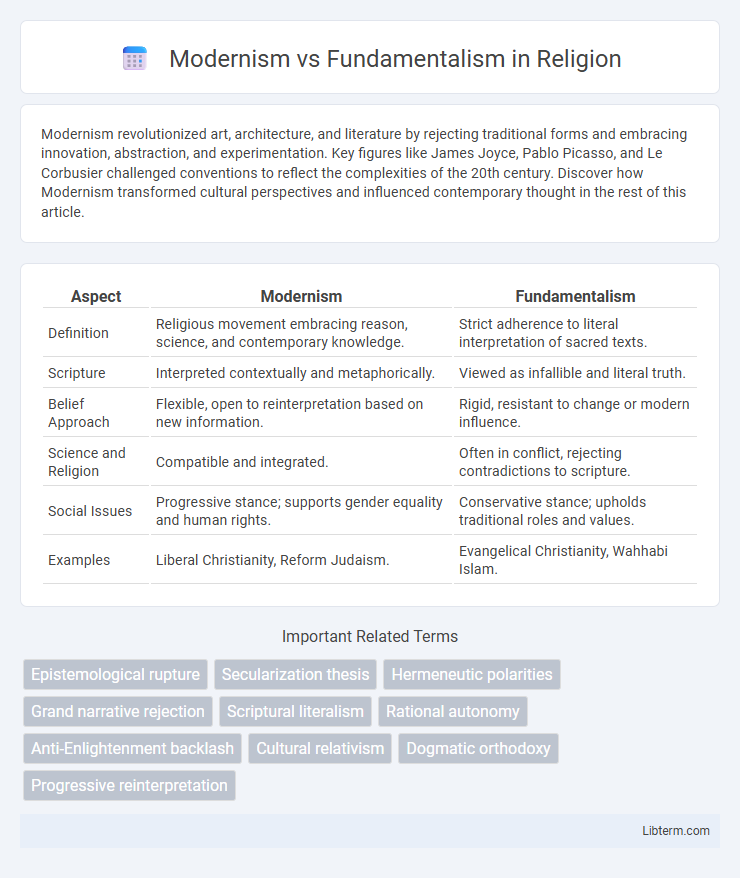Modernism revolutionized art, architecture, and literature by rejecting traditional forms and embracing innovation, abstraction, and experimentation. Key figures like James Joyce, Pablo Picasso, and Le Corbusier challenged conventions to reflect the complexities of the 20th century. Discover how Modernism transformed cultural perspectives and influenced contemporary thought in the rest of this article.
Table of Comparison
| Aspect | Modernism | Fundamentalism |
|---|---|---|
| Definition | Religious movement embracing reason, science, and contemporary knowledge. | Strict adherence to literal interpretation of sacred texts. |
| Scripture | Interpreted contextually and metaphorically. | Viewed as infallible and literal truth. |
| Belief Approach | Flexible, open to reinterpretation based on new information. | Rigid, resistant to change or modern influence. |
| Science and Religion | Compatible and integrated. | Often in conflict, rejecting contradictions to scripture. |
| Social Issues | Progressive stance; supports gender equality and human rights. | Conservative stance; upholds traditional roles and values. |
| Examples | Liberal Christianity, Reform Judaism. | Evangelical Christianity, Wahhabi Islam. |
Introduction to Modernism and Fundamentalism
Modernism in theology emphasizes the adaptation of religious beliefs to align with contemporary scientific knowledge and cultural advancements, advocating critical analysis of scriptures and openness to change. Fundamentalism asserts the literal interpretation of religious texts, aiming to preserve traditional doctrines against modernist influences and cultural relativism. These contrasting approaches shape ongoing debates within religious communities regarding faith, authority, and interpretation.
Historical Origins of Modernism
Modernism emerged in the late 19th and early 20th centuries as a response to rapid industrialization, scientific advancements, and secularization, marking a shift from traditional beliefs towards progressive ideas. It sought to reconcile religion with modern knowledge, emphasizing reason, critical thinking, and the reinterpretation of sacred texts. Key figures such as William James and Friedrich Schleiermacher influenced Modernism's theological framework, contrasting sharply with Fundamentalism's strict adherence to literal scripture.
Roots and Rise of Fundamentalism
Fundamentalism emerged in the early 20th century as a reaction against the Modernist movement's emphasis on scientific rationalism and secularism, which many perceived as threats to traditional religious beliefs. Its roots lie in a strict adherence to literal interpretations of sacred texts, aiming to preserve core doctrines from the perceived moral decay and relativism propagated by modernist thought. The rise of fundamentalism gained momentum through social and political upheavals, growing fear of cultural change, and the desire to reaffirm religious identity in rapidly changing societies.
Core Principles of Modernist Thought
Modernist thought centers on reason, empiricism, and progress, emphasizing scientific inquiry and individual autonomy as essential tools for understanding reality and improving society. It rejects absolute truths and embraces pluralism, encouraging diverse perspectives and continuous reinterpretation of knowledge in light of new evidence. Modernism advocates secularism and the separation of church and state, promoting human rights and democratic governance as foundations for social development.
Key Beliefs of Fundamentalist Movements
Fundamentalist movements emphasize the literal interpretation of sacred texts, rejecting modernist approaches that incorporate historical-critical methods or secular influences. Core beliefs include the inerrancy of scripture, the affirmation of traditional moral values, and the opposition to theological liberalism and secularism. These movements advocate for a return to perceived original doctrines and practices, often resisting cultural changes that contradict their scriptural understanding.
Modernism vs Fundamentalism: Philosophical Differences
Modernism emphasizes reason, scientific inquiry, and progressive interpretations of truth, often challenging traditional doctrines and advocating for individual autonomy. Fundamentalism asserts the inerrancy of sacred texts, upholds absolute moral laws, and resists relativistic or secular influences to preserve original religious teachings. The philosophical divide centers on Modernism's embrace of change and skepticism versus Fundamentalism's commitment to fixed doctrinal authority and literalism.
Impact on Society and Culture
Modernism propelled societal progress by championing science, reason, and individual freedom, fostering cultural innovation and challenging traditional norms. Fundamentalism, often rooted in strict religious or ideological adherence, influenced society by reinforcing conventional values and resisting modern changes. The tension between these movements shaped cultural dialogues, education, and political policies, reflecting a broader struggle over identity, authority, and social cohesion.
Conflict and Dialogue Between the Two Paradigms
Modernism and Fundamentalism often clash due to their contrasting approaches to tradition and change, with Modernism embracing scientific progress and critical inquiry while Fundamentalism adheres strictly to literal interpretations of religious texts. This conflict fuels intense debates over morality, education, and societal norms, influencing political and cultural landscapes worldwide. However, ongoing dialogue seeks common ground by exploring shared values such as justice and community, fostering mutual understanding despite profound ideological differences.
Influence on Religion, Politics, and Education
Modernism encouraged the adaptation of religious beliefs to align with scientific understanding and promoted secular governance, influencing politics by advocating for tolerance and democratic reforms, while emphasizing critical thinking and progressive curricula in education. Fundamentalism resisted these changes, insisting on literal interpretations of religious texts, advocating for policies rooted in traditional values, and supporting education systems that reinforce orthodox doctrines. The tension between Modernism and Fundamentalism shaped societal debates on the role of religion in public life and the direction of intellectual development.
Contemporary Relevance and Future Trends
Modernism emphasizes adaptation to scientific advancements and cultural pluralism, influencing contemporary efforts in policy-making and education to promote inclusivity and innovation. Fundamentalism, characterized by strict adherence to traditional beliefs, persists in shaping social and political movements that challenge modernization and globalization trends. Future developments suggest an ongoing tension where digital communication amplifies both modernist perspectives and fundamentalist ideologies, impacting global discourse and ideological polarization.
Modernism Infographic

 libterm.com
libterm.com